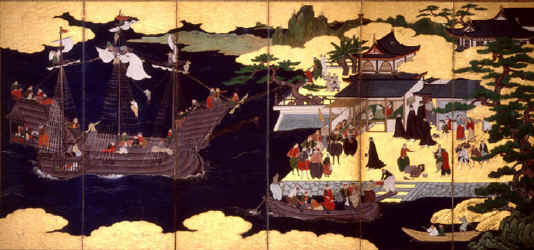|
In
Edo, ukiyo-e (woodblock prints of everyday life)
came into vogue among the common people in the
mid-eighteenth century. Thus followed the golden age
of of ukiyo-e, characterized by colorful prints of
actors and beautiful women.
During this time Katsushika Hokusai and Ando Hiroshige
adopted the Western method of drawing in perspective
introduced by such painters as Shiba Kokan through
Nagasaki, the only port open to foreign trade. Their
landscapes opened a new phase in ukiyo-e.
Full
scale contact with Western art following the Meiji
Restoration created in Japan a new tradition of
Western-style painting (yoga), mainly in oils, in
addition to influencing the time-honored Japanese style of
painting (Nihonga). Contemporary Japanese art
has been strongly influenced by postwar American pop art
and other art forms.
More...
Back to Top

THE
INFLUENCE OF BUDDHISM AND CHINA
With the arrival of
Buddhism from Korea and China there was a movement toward
painting, especially with the ruling class taking such
interest in the Buddhist culture and religion.
Painting during the seventh and eight centuries mimicked
styles started in China with illustrations of Buddha's
life and other deities of Buddhism. Painting became
greatly affected by Joko Shinko (Pure Land Buddhism) after
the tenth century.
With the ruling
class' encouragement, construction was started in
different areas for temples and monastic compounds during
the sixth and seventh centuries. Buddhist art was
commissioned for the temples, especially in the halls and
chapels. Some examples are Asukadera, Shitennoji and
Horyuji. Some of the most important paintings of
this period can be found in Horyuji's Golden Hall which
contains murals. In the temples there are also
sculptures that represent the various Buddhas and other
deities.
Back
to Top
Yamato-e started to
replace the Chinese painting style in the middle of the
Heian period. This style can be found on sliding and
folding screen and it shows or depicts the Kyoto scenery.
The album leaf and the illustrated handscroll (emaki) are
two types of painting formats that came along at the same
time. The most famous emaki painting can be
found in the Tales of Genji (published circa 1130).
With power changing
to the samurai from the nobility, the nobility managed to
keep a vast amount of their wealth and were patrons of
different styles of art. Typical examples of
the nobilities taste in art can be found in conservatism.
This along with realism, the samurais choice of art, were
two major trends found in the Kamakura period (1185-1333).
The introduction of
architecture and artistic work different from that of
other sects came about with Zen Buddhism in the thirteenth
century. Ink painting became the art style of choice
in the prominent Zen monasteries of Kamakura and Kyoto,
thus taking over scroll painting styles. Plain and
severe monochrome styles were preferred by Zen painters
and their patrons with it's introduction from Sung
(960-1279) and Yuan (1279-1368), China. Near
the end of 1400, these painters (and patrons) began to
prefer monochrome landscape painting (suibokuga).
More...
Back to Top |






